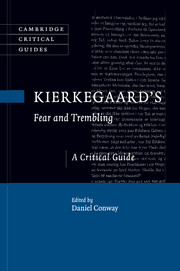Book contents
- Frontmatter
- Contents
- List of Contributors
- Acknowledgments
- List of Abbreviations
- Introduction
- Chapter 1 Homing in on Fear and Trembling
- Chapter 2 Fear and Trembling’s “Attunement” as midrash
- Chapter 3 Johannes de silentio’s dilemma
- Chapter 4 Can an admirer of silentio’s Abraham consistently believe that child sacrifice is forbidden?
- Chapter 5 Eschatological faith and repetition: Kierkegaard’s Abraham and Job
- Chapter 6 The existential dimension of faith
- Chapter 7 Learning to hope: the role of hope in Fear and Trembling
- Chapter 8 On being moved and hearing voices: passion and religious experience in Fear and Trembling
- Chapter 9 Birth, love, and hybridity: Fear and Trembling and the Symposium
- Chapter 10 Narrative unity and the moment of crisis in Fear and Trembling
- Chapter 11 Particularity and ethical attunement: situating Problema III
- Chapter 12 ‘He speaks in tongues’: hearing the truth of Abraham’s words of faith
- Chapter 13 Why Moriah?: weaning and the trauma of transcendence in Kierkegaard’s Fear and Trembling
- Bibliography
- Index
Chapter 9 - Birth, love, and hybridity: Fear and Trembling and the Symposium
Published online by Cambridge University Press: 05 February 2015
- Frontmatter
- Contents
- List of Contributors
- Acknowledgments
- List of Abbreviations
- Introduction
- Chapter 1 Homing in on Fear and Trembling
- Chapter 2 Fear and Trembling’s “Attunement” as midrash
- Chapter 3 Johannes de silentio’s dilemma
- Chapter 4 Can an admirer of silentio’s Abraham consistently believe that child sacrifice is forbidden?
- Chapter 5 Eschatological faith and repetition: Kierkegaard’s Abraham and Job
- Chapter 6 The existential dimension of faith
- Chapter 7 Learning to hope: the role of hope in Fear and Trembling
- Chapter 8 On being moved and hearing voices: passion and religious experience in Fear and Trembling
- Chapter 9 Birth, love, and hybridity: Fear and Trembling and the Symposium
- Chapter 10 Narrative unity and the moment of crisis in Fear and Trembling
- Chapter 11 Particularity and ethical attunement: situating Problema III
- Chapter 12 ‘He speaks in tongues’: hearing the truth of Abraham’s words of faith
- Chapter 13 Why Moriah?: weaning and the trauma of transcendence in Kierkegaard’s Fear and Trembling
- Bibliography
- Index
Summary
Death is a grim reaper; birth, a seedling, full of hope. Birth is the promise of beginnings and fresh starts. Death is news that there are no more beginnings or fresh starts. Death is familiar philosophical fodder. But why do finales trump brave openings and beginnings? Why are birth, hope, and new growth so seldom explored philosophically? Perhaps we take Silenus’ bitter warning to heart, “Better to die young, best never to have been born.” Then there is Job’s aching misogyny: “Man who is born of a woman is of few days and full of sorrow: he cometh forth like a flower and is cut down.” Could he have been spared if he were not born of a woman, if he had been born of an angel, a demon, of God, or (heaven forbid!) … of a man?
Gender, mortality, natality
To talk of birth and beginnings is to talk of women, wombs, and nursing, and many have thought that these are hardly fit topics for philosophical discussion. Kierkegaard may be the exception here. Death may seem more noble a topic, yet Kierkegaard, as we will see, can give nobility to mothers, to birthing and to weaning. We are mortal and born, and “of woman born.” Hannah Arendt holds that the condition of natality – of being born – is a limit-condition of life just as momentous as mortality. In Fear and Trembling, Kierkegaard brings birth and the maternal into philosophical focus. Death may be revitalizing, as Kierkegaard noticed. Birth can let us absorb the intimate wonder that I exist, in this body, in this age, in this language, held and released by this brother, by this mother.
- Type
- Chapter
- Information
- Kierkegaard's Fear and TremblingA Critical Guide, pp. 166 - 187Publisher: Cambridge University PressPrint publication year: 2015
- 1
- Cited by



